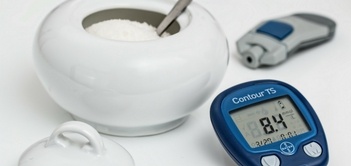As your age increases, so do your risks for various health conditions, especially if you are overweight and underactive. Type 2 diabetes, high blood pressure and high cholesterol can silently creep up on you along with unwanted pounds, wrinkles and gray hair. According to the Centers for Disease Control, nearly one in four people with diabetes are not aware they have this chronic medical condition.
 Diabetes occurs when a person’s glucose (also known as blood sugar) level is too high. When a person eats, the body breaks down most food into glucose, a simple sugar the body uses for energy. The glucose circulates throughout the bloodstream. The pancreas, a gland near the stomach, produces insulin, a hormone that allows glucose to get into the body’s cells.
Diabetes occurs when a person’s glucose (also known as blood sugar) level is too high. When a person eats, the body breaks down most food into glucose, a simple sugar the body uses for energy. The glucose circulates throughout the bloodstream. The pancreas, a gland near the stomach, produces insulin, a hormone that allows glucose to get into the body’s cells.
However, if the body does not make enough insulin or cannot use it properly, then glucose can’t get into cells to provide energy. Instead, glucose builds up in the bloodstream and passes out of the body in urine. High levels of blood glucose can harm the heart, blood vessels, kidneys, feet and eyes.
About 30 million people in the United States have diabetes, while another 84 million people have prediabetes. Someone with prediabetes has blood glucose levels that are higher than normal but not high enough for a diagnosis of diabetes. People with prediabetes are more likely to develop type 2 diabetes. Both diabetes and prediabetes are associated with an increased risk for heart attack and stroke.
Know Your Risks
In addition to age and weight, some other risk factors for diabetes and prediabetes include family history, ethnicity, high blood pressure and lack of physical activity. You can take a test to assess your risk for prediabetes or diabetes. Be sure to follow up with your physician regarding any health concerns.
Preventing Diabetes
Lifestyle changes can make a difference in preventing prediabetes and type 2 diabetes. The Office of Disease Prevention and Health Promotion recommends these four steps:
- Eat healthy: Choose foods low in saturated fat, added sugars and sodium (salt). Drink water instead of sweetened beverages, like soda or juice.
- Be active: Physical activity, such as fast walking, can lower the risk of type 2 diabetes. Consult a physician to determine what exercise program is best.
- Maintain a healthy weight: Even a slight loss can help reduce risks. For someone who is overweight, losing 5 to 7 percent of your starting weight can make a difference.
- Get your blood pressure and cholesterol checked: Visit your physician at least annually to track your numbers. Keeping blood pressure and cholesterol at healthy levels reduces the potential for heart attack and stroke.
Managing Diabetes
Diabetes can’t always be prevented. For someone with diabetes, the National Institute of Diabetes and Digestive and Kidney Diseases recommends the following ABCs:
A – A1C Test: The A1C test measures the average blood glucose level over a three-month period. It is important to keep your A1C number within the goal established by you and your doctor. It may require a healthy diet, medications or insulin to achieve the desired number.
B – Blood Pressure: Keeping blood pressure within safe limits is good for your heart and circulatory system. For most people with diabetes, the goal is to maintain blood pressure below 140/90 mm Hg.
C – Cholesterol: LDL (or “bad”) cholesterol can build up and clog blood vessels, which may result in a heart attack or stroke. On the other hand, HDL (or “good”) cholesterol helps remove “bad” cholesterol from the body. Your physician may prescribe medications to help keep cholesterol levels within a recommended range.
S – Stop Smoking: Diabetes narrows blood vessels, and smoking does too. Not smoking can help your heart work more effectively.
At ComForCare/At Your Side Home Care, our goal is to help older adults live their best life possible, despite chronic health conditions such as diabetes. Home care services can help older adults by providing medication reminders, transportation to physician appointments, companionship for walks and assistance preparing healthy meals. Contact us to learn more.
![Duel-Logo-CFC-AYS[rgb]](https://blog.comforcare.com/hs-fs/hubfs/Duel-Logo-CFC-AYS%5Brgb%5D.jpg?width=525&name=Duel-Logo-CFC-AYS%5Brgb%5D.jpg)
